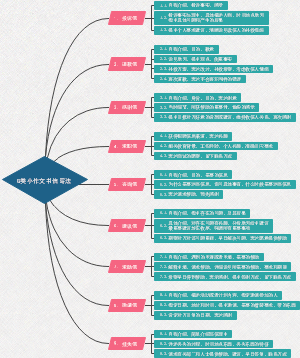导图社区 2005完形填空
- 42
- 3
- 0
- 举报
2005完形填空
考研2005完形填空复盘(自用),如①The explanation for insensitivity to smell seems to be that the brain finds it(形式宾语)
编辑于2023-04-30 20:56:26 广东- 相似推荐
- 大纲
2005完形填空
第一段
①The human nose is an underrated tool.(人的鼻子是一种被低估的工具。) ②Humans are often thought to be insensitive smelles compared with animals, 1 this is largely because, 2 animals, we stand upright.(和动物相比,人类常常被认为嗅觉不够灵敏。而这主要是因为我们和动物不同,我们是直立的。) ③This means that our noses are 3 to perceiving those smells which float through the air(先行词为smells的定语从句), 4 the majority of smells which stick to surfaces(地面).(这意味着我们的鼻子的感知只限于在空气中飘过的气味,会遗漏附在物体表面的大多数气味。) ④In fact, 5 , we are extremely sensitive to smells, 6 we do not generally realize it.(然而,事实上,我们对气味非常敏感,即便我们一般意识不到这一点。) ⑤Our noses are capable of 7 human smells even(递进词) when these are 8 to far below(不及)one part in one million. (即使把人类气味的浓度稀释到不及原来的百万分之一,我们的鼻子仍然能够察觉到它的存在。)
第一步:阅读全文首句,抓中心。根据①句得出正向关系。
题1:②是负向,与①呈现对立关系,选C。
同义相斥原则:两让步一转折选转折,两转折一让步选让步。
题2:根据对立关系,选B。
C.excluding 除......之外
D.besides 除......之外(还有)
题3:③句解释②句,则②句与③句逻辑相同。由the majority of可知本题强调的数量关系。选A。
A.limite 限制(数量)
D.confine 限制(活动空间)
be confined to
B.commit 委托
题4:根据前文逻辑,选C。
B.ignore 视而不见(故意;主观)
C.missing 错过(客观)
题5:考察句间逻辑。in fact 表示递进/对立/强调。ABC都可表示对立关系,只有B可以作插入语;如果该空前后没有逗号,ABC三项都对。选B。
让步词在句子中间且有逗号隔开,则句子重点在逗号前;转折词在句子中间,则句子重点在转折词后。
A.anyway 反正;尽管
有强调意味。
B.though 尽管
表对立(对同一件事情的相反评价)
anyway、though都表示尽管时,放句中,though可作插入语,插入语翻译时放到最前面。
C.instead 相反
相反、反而;表对比(两件不一样的事情)
instead如果放句首,需要加逗号。instead在语言上存在着对比关系,但不存在着对立关系。
eg1. He didn't answer the question. Instead, he left.(没有推翻前面的事)
eg2. With characteristic confidence, Dickens successfully insisted that Seymour's pictures illustrate his own story instead.
D.therefore 因此
题6:经典not题:当一个空的前后有not,而该题又为逻辑关系题时,则该题一定选对立逻辑。选A。
A.even if 让步逻辑
even if= even though
B.if only 要是…多好(虚拟)
eg.He would have been alive, if only he had...
C.only if 只有当
only if= if
D.as if 仿佛
eg.On a really good day, it no longer feels as if you are "making time to read".
题7:考察词义的理解。选D。
A.distinguishing 辨别(辨别的对象多于两种不同的味道)
B.discovering 发现(有目的性)
D.detecting 探测到;感知到(无目的性)
表示“感知”时,detect与③句中的perceive为同义词。
题8:考察词义的理解。选A。
A.diluted 稀释、冲淡(浓度),用于液体和气体。
B.dissolved 溶解,用于液体。
C.dispersed 分散 (范围)
D.diffused 扩散 (范围)
第二段
①Strangely, some people find that they can smell one type of flower but not another, 9 others are sensitive to the smells of both flowers.(奇怪地是,一些人发现他们可以闻到某种花香,却闻不到另一种,而另一些人则对两种花香都很敏感。) ②This may be because some people do not have the genes necessary to generate 10 smell receptors(感受器) in the nose.(这可能是因为前者缺乏一种在鼻子里生成某种特定气味感受器的基因。) ③These receptors are the cells which sense(感知) smells and send 11 to the brain.(这些感受器是可以感知气味并向大脑发送信息的细胞。) ④However, it has been found that even people insensitive to a certain smell 12 can suddenly become sensitive to it when 13 to it often enough.(然而,研究发现,即使是最初对某种特定气味不敏感的人,如果经常接触这种气味,也会突然变得 对它敏感起来。)
题9:根据①句前面的not可看出,本题考察句内对立逻辑,选D。
D.whereas 然而
题10:与④句的certain对应,选B。
B.particular 特殊的、专门的
题11:考察词义的理解。选C。
A.signs 标记(静态有形)
signal 信号(动态无形)
B.stimuli 刺激物(外部事物)
C.messages 信息
D.impulses 冲动、脉冲(电)
题12:由④句suddenly和when可知,12空为时间概念。选A。
B.at all 全然(否定)
C.at large 在逃的
D.at times 有时的
题13:考察词义的理解。选D。
A.subjected 受到
B.left 由…决定
C.drawn 被…吸引
D.exposed 暴露于
be exposed to 接触
第三段
①The explanation for insensitivity to smell seems to be that the brain finds it(形式宾语) 14 to keep(不定式)all smell receptors working all the time but can 15 new receptors if necessary.(对气味不敏感的解释似乎是这样的:大脑认为让所有的气味感受器一直工作的话效率太低,但是在必要时也可以产生新的感受器。) ②This may 16 explain why we are not usually sensitive to our own smells—We simply do not need to be.(这也可以解释为什么我们总是对自己的气味不敏感——只是不需要而已。) ③We are not 17 of the usual smell of our own house but we 18 new smells when we visit someone else's.(我们察觉不到自己家中惯有的气味,但是当我们拜访他人家中时就会注意到自己不熟悉的气味。) ④ The brain finds it best to keep smell receptors 19 for unfamiliar and emergency signals 20 the smell of smoke, which might indicate the danger of fire.(大脑发现最好是让气味感受器可随时用于接收不熟悉的、危急的信号,例如可能意味着有火险的烟味。)
题14:考察词义的理解。选C。inefficient表示起作用了,效果甚微;ineffective表示没有起作用。
A.ineffective 没有效果的、不起作用的=useless
B.incompetent 不称职的
C.inefficient 效率低的
D.insufficient 不充分的
题15:根据15空后面的new可知,选D。
B.summon 召唤
C.trigger 触发
D.create=generate 创造
题16:并列关系,选B。
B.also 也(两件事)
题17:not… but…二次转折,A转到B,B再转回A,17题与18题需要填同义词。注意同物比较。选C。
题18:not… but…二次转折,A转到B,B再转回A,17题与18题需要填同义词。注意同物比较。选D。
B.repel 击退
题19:keep A +adj. for B 让A对于B来说是怎样的。选A。(让气味接收器对紧急气味而言是可以识别的。)
A. available 可获得的
C.identifiable 可识别的 带入文中意思会相反
题20:signals为复数名词,smell为单数名词表示总分逻辑。本题是最常见的为举例。选B。
C.along with 除某物之外/和……一起
D.aside from 除了









